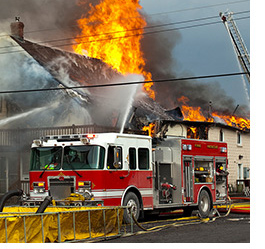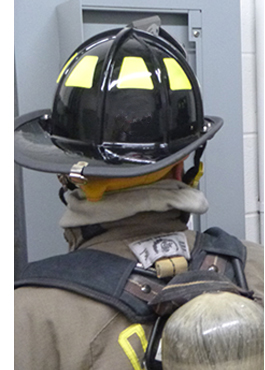| |
Utility control during structural firefighting operations:
Your key response strategies
Structural firefighting operations place firefighters in direct proximity to gas and electric utility lines that may be compromised by fire conditions or by the fire suppression effort itself. These utility lines may pose hazards to a structure’s occupants as well as to you and your team.
 When responding to a structure fire, remember that utility personnel are the experts in utility control. As soon as a structure fire has been confirmed, your dispatch center should initiate calls to all utility companies that serve the property. (Some dispatch centers have a policy of automatic utility notification for all confirmed structure fires.) National Grid or the local electricity and natural gas providers should be asked to respond to every structure fire. Once on the scene, the utility representative should be incorporated into the command structure.
Essential pre-planning
Conduct pre-planning for target hazards in your response area, such as hospitals and commercial/industrial buildings that pose significant risks. Schedule crews to conduct building walkthrough inspections to locate the type and location of all utilities. Keep in mind that the location of utility infrastructure and the utility controls in each structure are unique.
Operational considerations
It is essential to consider the time and personnel that may be required to properly secure compromised utility systems. Utility representatives can provide guidance as soon as they arrive on the incident scene.
 These steps can help you protect yourself and a building’s occupants from electrical shock hazards and natural gas risks:
- Upon arrival at the incident scene, identify the location of utilities during your 360-degree size-up.
- During operations, communicate the status of utilities to operating crews and your dispatch center.
- Work with utility company personnel to coordinate the safe control of utilities.
- If the electrical panel is accessible and it is safe to utilize the breakers in the panel, shut off electrical breakers, working from the bottom breaker up to the main breaker.
- Other than in the case of a rescue, consideration should be given to securing utilities before entering hazardous areas, especially those that accumulate water in proximity to electricity.
- Be aware that fire conditions may cause energized power lines to sag or become disconnected from their structure and drop to the ground.
- Even after the electricity has been turned off, a backup generator may be in place and begin to operate. Treat all wires, machines and appliances inside the structure as potentially energized, and stay away.
- When water must be used to protect exposures, stay at least 30 feet away from the source of electricity or any energized objects. Use a 30-degree fog pattern
at 100 psi.
 - Ensure that all personnel, ladders and equipment remain at least 10 feet away from power lines.
- If you have been trained to do so, you may stop gas service by shutting off the service valve located on the piping before the gas meter. A gas service valve is closed when the valve lug is perpendicular, or crosswise, to the gas pipe. Inform National Grid of any gas service valve that has been closed. Once a service valve is closed, only National Grid may re-open it.
- Let gas fires burn until the source has been turned off.
- If unignited gas is being released into the involved structure, evacuate the building.
- If a leak is suspected, check the surrounding area and structures for the presence
of gas.
- Coordinate with National Grid or the local energy provider to restore electric and
gas service.
| |
What NOT to do:
|
|
| |
- Do NOT extinguish burning gas.
- Do NOT open any type of gas valve that has been closed.
- Do NOT operate underground gas pipeline valves.
- Do NOT use a solid stream of water to protect exposures around energized power lines or equipment.
- Do NOT stand on the ground when operating aerial equipment in the vicinity of power lines.
|
- Do NOT cut electrical lines, even if
you believe that they have been
de-energized.
- Do NOT move downed
electrical wires.
- Do NOT disconnect the service
wiring on a structure.
- Do NOT pull the electrical meter out
of the meter socket.
- Do NOT enter utility vaults or
switching cabinets.
|
|
| |
| |
Case in point:
Two Michigan firefighters operating at a structure fire were shocked by electricity in the basement of the home
In May 2018, a rural Michigan fire department responded to the report of a structure fire with occupants trapped. During the course of firefighting operations, crews rescued two occupants and a dog from the second floor. Crews then proceeded to the basement to locate the seat of the fire. They encountered heavy smoke conditions and received a jolt of electricity conducted through water that had accumulated in the basement. One firefighter was hospitalized in serious condition with a heart abnormality, and all other crewmembers felt tingling and numbness in their extremities.
|
|
|
Learn more gas and electrical utility response tips at
firstresponder.ngridsafety.com.
 National Grid’s free First Responder Utility Safety Training Program has helped thousands of emergency response personnel learn to operate safely during incidents involving utility hazards. This program, which includes gas and electric certification trainings, covers natural gas pipelines and electric power lines as well as other facilities.
National Grid’s free First Responder Utility Safety Training Program has helped thousands of emergency response personnel learn to operate safely during incidents involving utility hazards. This program, which includes gas and electric certification trainings, covers natural gas pipelines and electric power lines as well as other facilities.
Through this training, you will gain the knowledge, skills and technical ability required to respond to the most common electrical and natural gas emergencies.
Our certification programs are self-paced. Users who complete the gas and electric programs will earn personalized certificates of completion.
Keep yourself, your team and the public safe. Register
today, and complete your utility safety training. Visit firstresponder.ngridsafety.com.
 |
|
Smell Gas. Act Fast. |
| |
| |
| |
Massachusetts contacts
Gas emergencies:
1-800-233-5325 and 911
Electric emergencies:
1-800-465-1212 and 911
|
|
New York contacts
Gas emergencies:
Long Island and the Rockaways:
1-800-490-0045 and 911
Metro NY:
911 and 1-718-643-4050
Upstate NY:
1-800-892-2345 and 911
Electric emergencies:
1-800-867-5222 and 911
|
|
Rhode Island contacts
Gas emergencies:
1-800-640-1595 and 911
Electric emergencies:
1-800-465-1212 and 911
|
|
| |
|
|

